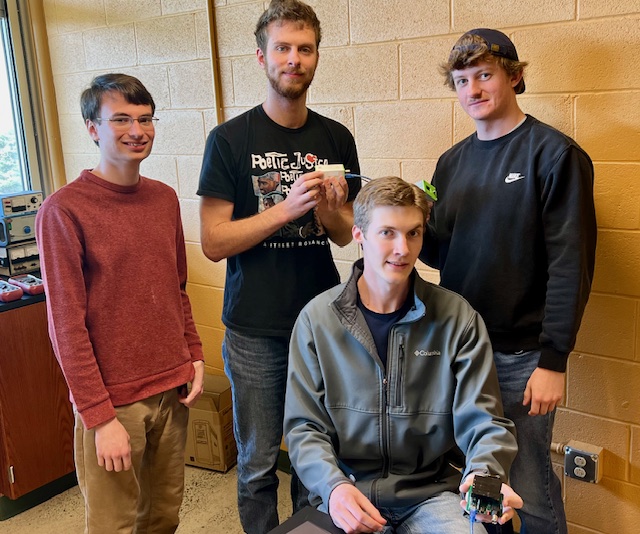SVC Physics Researchers Search for Possible Effects of Solar Eclipse on Cosmic Showers
Submitted by Saint Vincent College
 In the time it takes to read this sentence, your body will be bombarded by hundreds of subatomic particles called muons, fundamental building blocks of the universe that are created when particles in the Earth’s atmosphere collide with cosmic rays. Muons exist for only 2.2 microseconds but travel far before decaying—penetrating up to a mile into the Earth’s crust—because they move at nearly the speed of light.
In the time it takes to read this sentence, your body will be bombarded by hundreds of subatomic particles called muons, fundamental building blocks of the universe that are created when particles in the Earth’s atmosphere collide with cosmic rays. Muons exist for only 2.2 microseconds but travel far before decaying—penetrating up to a mile into the Earth’s crust—because they move at nearly the speed of light.
“Muons are passing through us all the time,” said Dr. Dan Vanden Berk, associate professor of physics in the Herbert W. Boyer School of Natural Sciences, Mathematics and Computing at Saint Vincent College. “We really can’t do much about them, and most of them don't affect us at all. But they're energetic enough that sometimes, if you're really unlucky, they'll hit a DNA molecule and [mutate it].”
Over the past five years, physics students and faculty at Saint Vincent have monitored and studied muons via a cosmic shower detector array (CSDA) project. “Cosmic showers are cascades of subatomic particles that are created when very high-energy particles from space interact with the Earth’s atmosphere,” said Fr. Michael Antonacci, O.S.B., C’07, S’14, assistant professor of physics at Saint Vincent. “A muon is one of the few cosmic shower particles that survive long enough to reach the surface of the Earth and be detected.”
Scientists are working to fully understand cosmic showers—their effects on the planet and people, where they originate, whether they vary in time and direction, and so on. On April 8, Saint Vincent’s CSDA project team will take its muon detectors to Erie, PA, aiming to help determine if the total solar eclipse will affect the rate of muons pelting the Earth.
The eclipse will pass over North America from Mexico’s Pacific coast to the Atlantic coast of Newfoundland, Canada. Parts of Oklahoma, Arkansas, Missouri, Illinois, Kentucky, Indiana, Ohio, Pennsylvania, New York, Vermont, New Hampshire and Maine will experience a total eclipse, if the weather cooperates. Sky-gazers in Erie will see a total eclipse at 3:18 p.m. EDT.
Although the Pittsburgh area is not in the path of totality, a partial eclipse (95 percent of the sun will be covered) will be visible from 2 p.m. to 4:30 p.m.
Four Saint Vincent physics majors who work on the CSDA project—Adrianna Battaglia, C 26; John Meneghini C 24; Coty Walters, C 25; and Matthew Vanden Berk, C 25—will be joined in Erie by a half-dozen or so members of the SVC physics club. The group will set up its equipment at the St. Mark’s Seminary.
“The next [total eclipse] won’t be for another 20 years, so we’re trying to take advantage of it the best we can,” Dr. Vanden Berk said. “We're going to measure more than a dozen things—background radiation, the muon counts, temperature, pressure, humidity and magnetic field strength—see if we get changes throughout the eclipse.”
Scientists are certain that variations in atmospheric pressure, temperature and the weather can alter muon counts. There are conflicting studies about whether muron counts correlate with an eclipse. On the day of the partial solar eclipse in October 2023, the SVC team found its counts from the on-campus detectors were higher than usual.
“We realized later it wasn't caused by the eclipse, but by a change in the weather,” Dr. Vanden Berk said. “It was not a good day for seeing the sun. Rain washes out radioactive particles and brings them closer to the ground, which causes an increase in radiation count rate.”